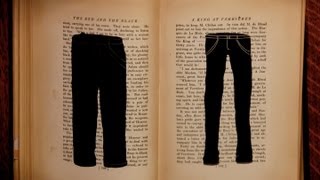(单词翻译:单击)
Mysteries of vernacular: Pants.
通用俗语的谜团:Pants。
An item of clothing that covers the body from the waist to the ankles or knees, each leg having a separate tubular piece.
Pants是指一种遮盖从腰部到脚踝或膝盖、每条腿都有一个单独的管状部分的衣物。
We also know them as "trousers".
我们也将其叫作'trousers'。
The history of the word "pants" begins in the 4th century with the Roman Catholic Saint Pantaleo.
'pants'这个单词的历史,最早起源于公元4世纪时罗马天主教圣庞大良。
Because Pantaleo was the patron saint of Venice, Venetians were commonly called "Pantaleonis".
因为庞大良是威尼斯的主保圣人,所以威尼斯人通常会称其为'Pantalones'。

In 16th century Italy, a type of comedy theater called Commedia dell'arte was born.
在16世纪的意大利,有一种叫作'Commedia dell'arte'的喜剧形式诞生了。
The masked characters of the theater were based on stock types,
这种戏剧里戴着面具的演员们,主要以定性角色(丑角)演出,
like the comic servant Harlequin, the clown Scaramouche and the miserly Venetian merchant Pantalone.
比如仆人哈利昆、小丑斯凯拉谟修以及吝啬的威尼斯商人潘塔隆内。
The Venetian trader's costume was distinguished by the particular cut of his trousers which the French began to call "pantaloons".
这位威尼斯商人的服装,以其被特别剪过的裤子为特征,法国人开始称之为'pantaloons'。
By the late 1700s, the word "pantaloons" had come to describe any style of trousers.
在18世纪末,'pantaloons'这个词已经被用来形容任何风格的裤子了。
As the word migrated to Britain, the lower class is shortened "pantaloons" to "pants".
随着这个词进入英国,下层人士将'pantaloons'缩写为'pants'。
though the upper class initially considered the abbreviation vulgar.
尽管上层人士在一开始认为这种缩写太粗俗了。
By the time Edgar Allan Poe printed the word in 1840, pants was a generally accepted term, with the meaning we know today.
随着埃德加·爱伦·坡于1840年将这个词印刷出来,'pants'成为了一个被普遍接受的词语,而意思也是我们今天所知道的。


